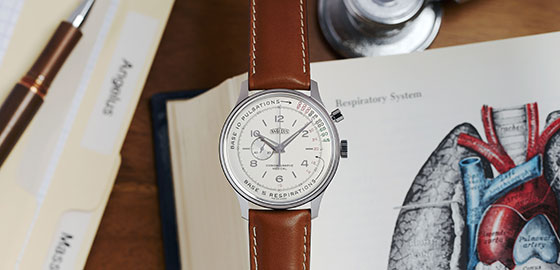
In the 1960s, Angelus launched its “doctor’s watch”: a wrist-worn hand-wound chronograph with a unique dial.
It presented a dual scale for reading the vital signs doctors need during patient examinations: a pulsometer – to measure the patient’s pulse – and an asthmometer – to record their respiratory rate. This rare piece, which follows the 1950s and 1960s trend of specialising chronographs to meet specific functional or professional requirements, has been brought up to date by Angelus to appeal to modern tastes – without any side effects.
In partnership with Massena LAB, the watchmaking brand released a 99-piece limited edition of the Chronographe Médical x Massena LAB. This re-edition differs from the original by several small details. The A5000 movement is a manual-winding Angelus calibre with integrated chronograph mechanism. The case is made from 316L steel, the surgical kind, as naturally befits a doctor’s watch. Lastly, the case diameter has been increased to 39mm to make the pulsometer scale more legible.
Displayed between 1 and 3 o’clock, it is based on 10 beats. As soon as the chronograph is started, simply count 10 beats, then stop the mechanism. When compared against the pulsometer scale, the chronograph hand will then indicate the number of beats per minute. The asthmometer displays the respiratory rate per minute. The Chronographe Médical works on the basis of five breaths. After starting the chronograph, count five breaths before pressing the pusher again. The chronograph hand will indicate the number of breaths per minute on the inner scale graduated from 40 to 10.
These functions, and how they are presented on the dial, remain unrivalled. Not only has the combination of pulsometer and asthmometer remained unique, but its display is also one of a kind. First and foremost, the pulsometer has a very specific colour code: green, black, or red, corresponding to the severity of the reading obtained during the examination. By contrast, the respiratory scale is red and is nestled inside the minute circle. These two scales are positioned so as to make them as clearly legible as possible. Before each scale, the requirement for taking vital signs is listed (base 10 pulsations and base 5 breaths). The font used is particularly wide, contrasting and impossible to miss. Two large arrows accentuate these scales, one of which, curved and crossing the minutes circle, is completely unique. Lastly, the silvered opaline dial and Dauphine hands with luminescent lines are identical to the model that inspired this timepiece.
April 20, 2023


 News
News